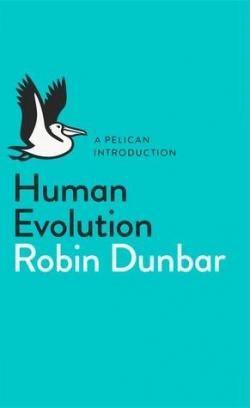
Robin Dunbar
Note moyenne : /5 (sur 0 notes)
Note moyenne : /5 (sur 0 notes)
Résumé :
What makes us human?How did we develop language, thought and culture?Why did we survive, and other human species fail? Robin Dunbar is an evolutionary psychologist and former director of the Institute of Cognitive and Evolutionary Anthropology at Oxford University. His acclaimed books include How Many Friends Does One Person Need? and Grooming, Gossip and the Evolution of Language, described by Malcolm Gladwell as 'a marvellous work of popular science.'
étiquettes
Ajouter des étiquettes
Critiques, Analyses et Avis (1)
Ajouter une critique
Un livre intéressant pour les amateurs de paléontologie et les curieux intéressés par la théorie de l'évolution.
L'anthropologue britannique Robin Dunbar propose une théorie de l'évolution fondée sur l'étude des systèmes sociaux de nos ancêtres préhumains basée sur le volume endocrânien. Dunbar postule qu'il est déterminé par la taille des groupes sociaux et en corrolaire par leurs besoins nutritionnels. Ensuite, il détermine le bilan des activités de nos ancêtres en fonction de la pression de l'environnement, de la consommation de nourriture et des liens sociaux. L'auteur estime que pour survivre, ces tribus et espèces ont dû mettre en place des mécanismes sociaux comme la religion, les contes et même le rire pour consolider leurs liens et se développer.
Si l'hypothèse des liens sociaux est assez connue et même soutenue par plus d'un spécialiste, en revanche il est difficile de confirmer le lien entre les pratiques sociales voires économiques et le volume endocrânien. Mais comme tout chercheur, Dunbar ne va évidemment pas critiquer sa théorie que du contraire.
L'anthropologue britannique Robin Dunbar propose une théorie de l'évolution fondée sur l'étude des systèmes sociaux de nos ancêtres préhumains basée sur le volume endocrânien. Dunbar postule qu'il est déterminé par la taille des groupes sociaux et en corrolaire par leurs besoins nutritionnels. Ensuite, il détermine le bilan des activités de nos ancêtres en fonction de la pression de l'environnement, de la consommation de nourriture et des liens sociaux. L'auteur estime que pour survivre, ces tribus et espèces ont dû mettre en place des mécanismes sociaux comme la religion, les contes et même le rire pour consolider leurs liens et se développer.
Si l'hypothèse des liens sociaux est assez connue et même soutenue par plus d'un spécialiste, en revanche il est difficile de confirmer le lien entre les pratiques sociales voires économiques et le volume endocrânien. Mais comme tout chercheur, Dunbar ne va évidemment pas critiquer sa théorie que du contraire.
Citations et extraits (1)
Ajouter une citation
The way ahead
[...]The approach that I will adopt here is very different. It exploits our much improved understanding of how primates allocate time to the various core activities (feeding, travel, rest, social bonding) that are crucial to their ability to survive in a particular habitat. This approach builds on a series of time budget models that we have developed for a number of monkey and ape species – models that allow us to predict exactly how much time an animal should devote to each of these core activities in a particular habitat. The key issue here is that the length of the working day is limited (we all sleep at night) and all these core activities have to be performed within the waking day. The fact that we are dealing with a biological system here is a crucial advantage: in biological systems, changes in one component cannot happen without having knock-on consequences elsewhere in the system. A species cannot increase its brain or body size without affecting the time it has to spend feeding, and it cannot change its feeding time allocation without affecting the time available for other equally crucial activities like travel or socializing. In a word, the numbers have to add up. And this gives us a powerful tool for exploring species’ responses to changing circumstances.
[...]The approach that I will adopt here is very different. It exploits our much improved understanding of how primates allocate time to the various core activities (feeding, travel, rest, social bonding) that are crucial to their ability to survive in a particular habitat. This approach builds on a series of time budget models that we have developed for a number of monkey and ape species – models that allow us to predict exactly how much time an animal should devote to each of these core activities in a particular habitat. The key issue here is that the length of the working day is limited (we all sleep at night) and all these core activities have to be performed within the waking day. The fact that we are dealing with a biological system here is a crucial advantage: in biological systems, changes in one component cannot happen without having knock-on consequences elsewhere in the system. A species cannot increase its brain or body size without affecting the time it has to spend feeding, and it cannot change its feeding time allocation without affecting the time available for other equally crucial activities like travel or socializing. In a word, the numbers have to add up. And this gives us a powerful tool for exploring species’ responses to changing circumstances.
autres livres classés : théorie de l'évolutionVoir plus
Les Dernières Actualités
Voir plus
Autres livres de Robin Dunbar (3)
Voir plus
Quiz
Voir plus
Pas de sciences sans savoir (quiz complètement loufoque)
Présent - 1ère personne du pluriel :
Nous savons.
Nous savonnons (surtout à Marseille).
10 questions
414 lecteurs ont répondu
Thèmes :
science
, savoir
, conjugaison
, humourCréer un quiz sur ce livre414 lecteurs ont répondu


























